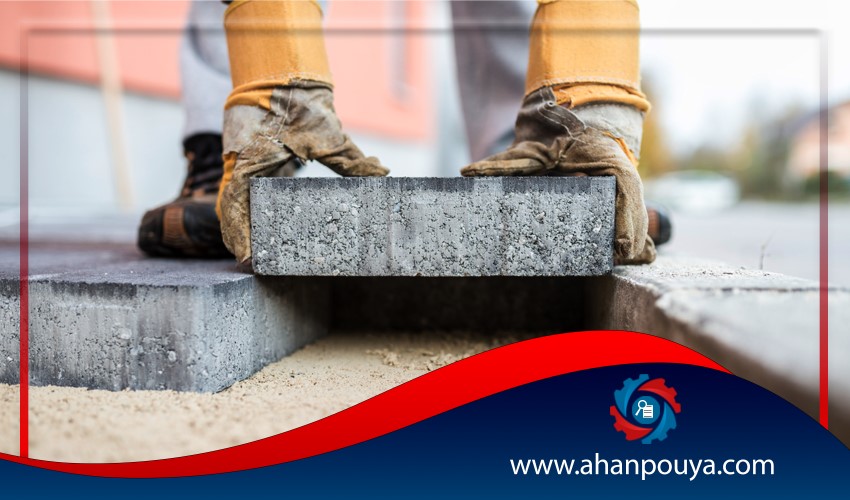
Concrete consists of three essential components of water , aggregate ( sand and sand ) and portland cement . Cement and concrete are different. in fact cement is one of the forming materials of concrete . Cement is often powdered and added to water and aggregates when mixed. The substance of this mixing came after the lapse of time. And it comes into a coherent way that is called concrete .
1.Portland cement : cement and water to form a cohesive matter Which causes aggregate and sand to stick to each other.
2.water : Water is needed for chemical reaction with cement (hydration) and it has a direct relationship with concrete performance . the amount of water consumed in concrete is expressed in terms of cement content , which is referred to as the ratio of water to cement . The lower the water to cement ratio or W / C, the higher the strength of concrete and the lower its permeability.
3.aggregates : the aggregate in the concrete consists of coarse particles of sand and gravel .
As hydration continues, the strength of the concrete increases This reaction is the cause of increasing the resistance of the concrete or the catch of the cement . Relative humidity must be at least 80% to process or continue the hydration process. In case the moisture is lower than this value , the concrete treatment has stopped. And if the relative humidity returns above 80%, the hydration process will start again.
Curing is the retention of moisture in concrete until the reaction between cement and water is complete. this can be done by temporary work insulation , water injection , or steam production .From a practical point of view, it is recommended to keep the concrete moist for 7 days when it is impossible The minimum curing time of concrete should not be less than 2 days.
Usually, instead of using a particular cement, it is possible to change some of the properties of the conventional cement used by combining it with an additive. chemical additives are basically Water reducers, retarders, and accelerators are classified under types A, C, B, and A in the ASTM Code, respectively. there are also other additives the main objective of their application is to protect concrete from harmful effects of weathering and thawing .
There are additives that accelerate the hardening of concrete And they raise the initial resistance of the concrete. Some examples of accelerators are: sodium carbonate ، aluminum chloride , potassium carbonate ، Sodium fluoride ، sodium aluminate ، Iron salts and calcium chloride.
There are additives that delay the setting time of concrete These materials are very useful in very hot weather, which shortens the normal setting time of concrete, and also to prevent the formation of cracks due to setting in successive concreting.
These add-ons are used for three purposes :
1.achieving higher strength by reducing water to cement ratio.
2.Achieve a certain efficiency by reducing the amount of cement used and consequently reducing the hydration temperature in the concrete mass.
3.simplicity of concrete.
This type of concrete has a strength of up to 10 to 40 MPa And the first catch is between 30 and 90 minutes . depending on the type of cement and weather conditions .
No rebar or reinforcement is used in this type of concrete. The main substance is cement , sand , and water . the specific gravity of the plain concrete is between 20 and 200 kg / m3 And has a resistance between 200 to 500 kg per square centimeter.
Because plain concrete has low tensile strength, tensile strength can be increased by reinforcing the concrete with reinforcement.
Prestressed concrete is used in large projects that require a lot of strength. This is a special technique in which the armatures are pulled before they reach the service load.
Different parts of a structure can be made in a pre - built factory and transferred it to the project site when needed. like concrete blocks. Using this technique increases the execution speed.
concrete with specific gravity of 105 kg / m3 can be placed in light concrete category . The use of light aggregate materials leads to weight loss.
Concrete with special weight ranges between 3000 and 4000 kilograms per cubic meter with special weight . This type of concrete is used in nuclear power plants and other similar projects.
In this type of concrete, by adding air-conditioning materials, frost resistance and successive melting and ice cycles are increased.
this type of concrete is used instead of cement and the particles of the aggregate are attached to the polymer by the use of the polymer .
Concrete with a strength of more than 40 MPa is called high strength. This concrete is obtained by reducing the water to cement ratio to 0.35.
This type of concrete is compacted by its weight and does not require vibration and vibration .
The main difference in this type of concrete is how to implement it . this type of concrete is sprayed to the surface of the armature . The higher the nozzle air pressure, the better the compaction operation of the concrete.
1.When the concrete sticks to the trowel or other executive equipment, it indicates the presence of too much sand or airborne material in the mixing design.
2.Excessive waterlogging leads to delayed hardening of the concrete and cause several problems on the concrete surface .
3.appliances for small concrete should all be cleaned .
4.Molds should be clean and thoroughly oiled.
5.Concreting should be done in such a way that the concrete remains in its pasty state and fills the space between the rebars.
6.Adding water to concrete after mixing is prohibited.
7.Concreting of roofs must be done consecutively.
8.concrete should be compacted during operation using appropriate means .

Ahan Pouya with more than a decade of best-selling experience, adheres to professional and ethical principles in the field of selling and buying at inside and outside the borders of Iran, helping you in the steel industry.